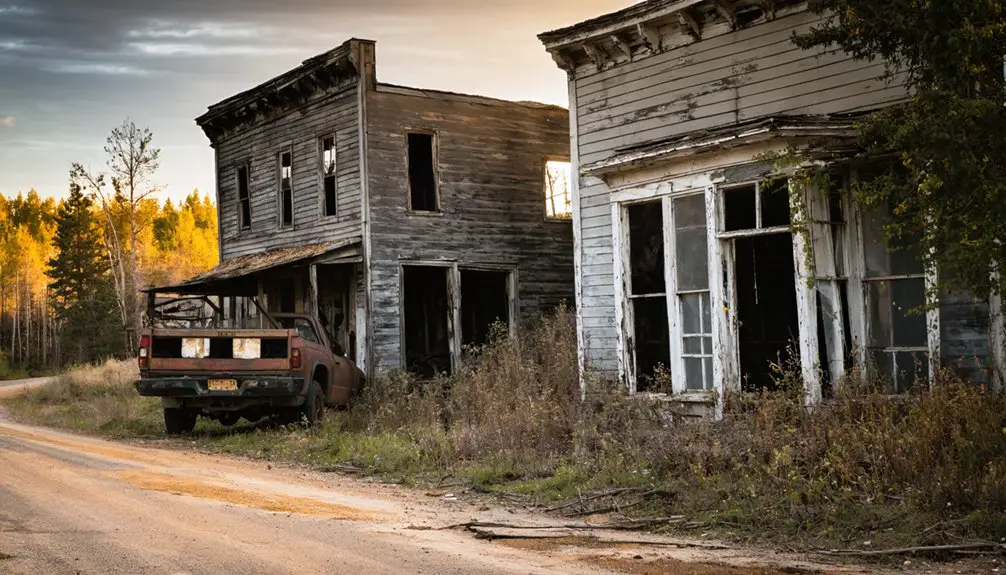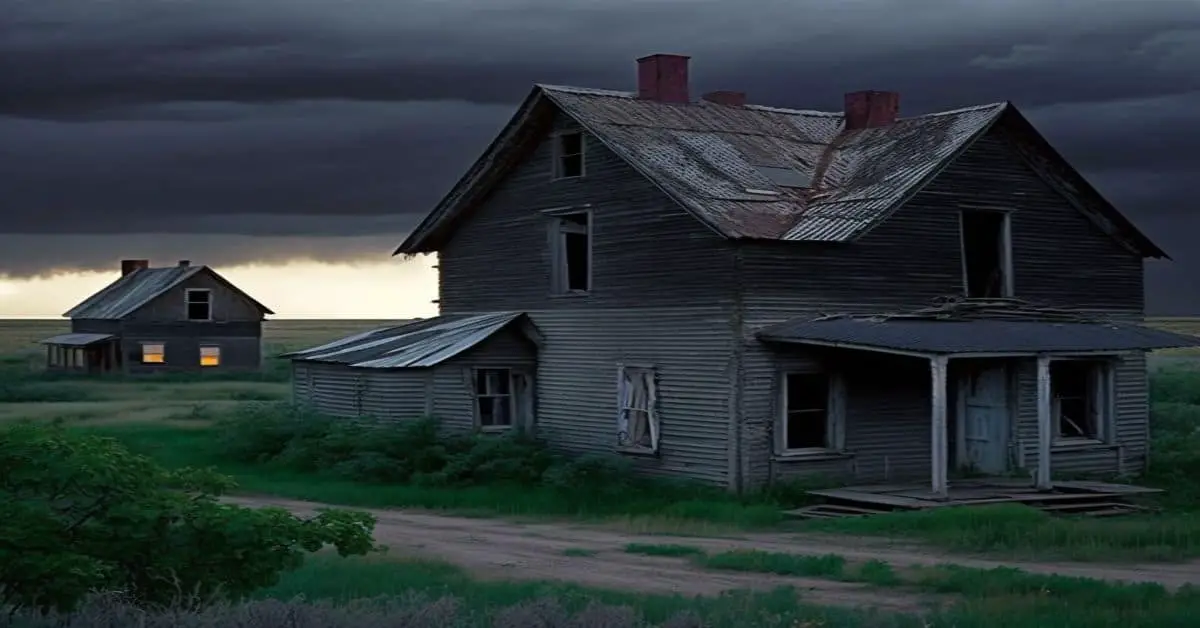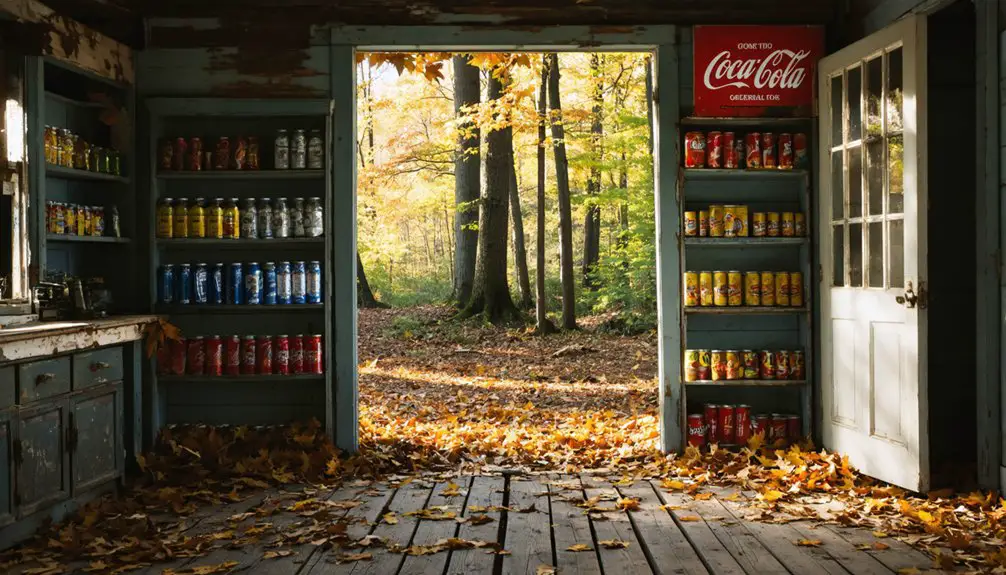You’ll find Madrid nestled in Maine’s western mountains, where gold discoveries in 1854 sparked a population boom from 351 to 404 residents. The Spanish-named settlement thrived with water-powered sawmills, producing white birch products for international markets. By 2000, this once-bustling frontier town’s population had dwindled to 173, leading to its disincorporation. Today, over 40 businesses and restored historic buildings tell the fascinating tale of Madrid’s rise and fall.
Key Takeaways
- Madrid, Maine lost its municipal status in 2000, becoming part of East Central Franklin unorganized territory after population dropped to 173.
- The town declined from a peak population of 437 in 1880 due to industry closures and changing economic conditions.
- Originally thriving from gold mining and lumber industries, Madrid’s economic base eroded throughout the 20th century.
- Historic buildings and mining artifacts are preserved, with the Coal Mining Museum maintaining the town’s ghost town heritage.
- Despite ghost town status, over 40 businesses operate today, with restored buildings housing art galleries, shops, and studios.
The Birth of a Spanish-Named Settlement
While many New England towns adopted European names during America’s westward expansion, Madrid, Maine emerged with a distinctly Spanish moniker when it was first settled around 1807.
You’ll find the story begins with Jonathan Phillips of Boston, who purchased the land from Massachusetts around 1790, followed by Jacob Abbott from Wilton, New Hampshire, who managed the settlement’s development. Unlike its Spanish namesake that sits 650 meters above sea level, the Maine settlement was built in the rugged mountains of western Maine. The Spanish capital’s history as a military fortress dates back to the 9th century when it was established by Muhammad I of Cordoba.
The naming significance went beyond mere European mimicry. Though Madrid, Maine had no direct Spanish cultural influences, the name choice reflected the common practice of using prestigious Old World references to attract settlers and establish a distinguished identity.
Gold Rush Fever and Early Growth
When gold was discovered in Madrid, Maine in 1854, the quiet farming settlement transformed into a bustling frontier town. You’d have found prospectors, many returning from disappointing ventures out West, enthusiastically working the Swift River and nearby streams for placer gold. The population swelled from 351 to 404 by 1859, as mining camps sprouted into proper settlements with essential services.
The community dynamics shifted dramatically as gold mining operations drew diverse newcomers to the area. You’d have seen miners supplementing their uncertain fortunes with farming and lumber work, while mining camps evolved into established neighborhoods. Like the earliest gold miners who arrived in 1822 at the Coal Bank site, these prospectors hoped to strike it rich in Maine’s mineral-rich terrain. The region experienced a short-lived boom as prospectors flooded into western Maine seeking their fortunes.
Lumber Mills and Industrial Glory Days
You’ll find Madrid’s industrial might centered along the Sandy River falls, where three sawmills and a gristmill transformed the rushing waters into mechanical power for lumber processing.
Like the first water-powered sawmill in South Berwick established in 1634, Madrid’s mills became vital to Maine’s lumber industry. These mills churned out white birch, ash for shovel handles, poplar for staves, and basewood products that would be shipped via rail from nearby Phillips.
The town’s specialty in white birch production earned it recognition as a “white birch town,” with its finished products reaching markets as far as Germany. Peavey hooks invented in 1858 helped workers efficiently maneuver logs at Madrid’s bustling mills.
Mill Operations and Production
Madrid’s lumber industry roared to life in the 1870s, with Charles Pickard establishing the first documented operations before Josiah F. Prescott took over.
The area’s most prominent operation, nicknamed ‘Sawdust City,’ showcased impressive mill technology that leveraged the Sandy River’s falls for power. Like many Maine lumber operations, the mills operated at peak efficiency during the winter months when frozen conditions made log transportation easier.
Water-Powered Industrial Success
The Sandy River’s powerful falls transformed Madrid into a thriving industrial center during the late 1800s, powering an impressive array of manufacturing facilities along its banks.
With water power driving three sawmills, a gristmill, and specialized machinery, you’d find a bustling hub of industrial innovations producing everything from lumber to carriage panels.
- Annual production included 1,200 cords of prized white birch shipped to furniture makers
- Specialized water-powered machines crafted clapboards and shingles for domestic and international markets
- Local hardwoods like ash were transformed into shovel handles while poplar became staves
- German markets enthusiastically sought Madrid’s high-quality sleigh panels
The town’s strategic location by the falls enabled efficient harvesting and processing of the surrounding forests’ rich hardwood resources, establishing Madrid as a renowned “white birch town” in the region.
Life in a Thriving 19th Century Community
During the mid-1800s, life in Madrid centered around a vibrant mix of agriculture and water-powered industry along the Sandy River. You’d find farmers harvesting 3,387 bushels of wheat in 1837, while watching the agricultural evolution from cattle to sheep and eventually dairy operations.
The town’s community cohesion strengthened through seven school districts with twelve schools serving a growing population of 437 by 1880. Located in Franklin County, Maine, the town’s strategic position helped foster its educational and social development. The historic Madrid Village Schoolhouse, built in 1872, became a cherished local landmark.
You could have worked at any of the three sawmills, one gristmill, or operated the clapboard and shingle machines that drove the local economy. Living here meant you’d likely split your time between tending crops in the fertile valleys and laboring in the mills.
The East Madrid and Abbott roads connected you to Phillips and broader markets, making Madrid a self-sustaining hub of rural enterprise.
The Long Road to Abandonment
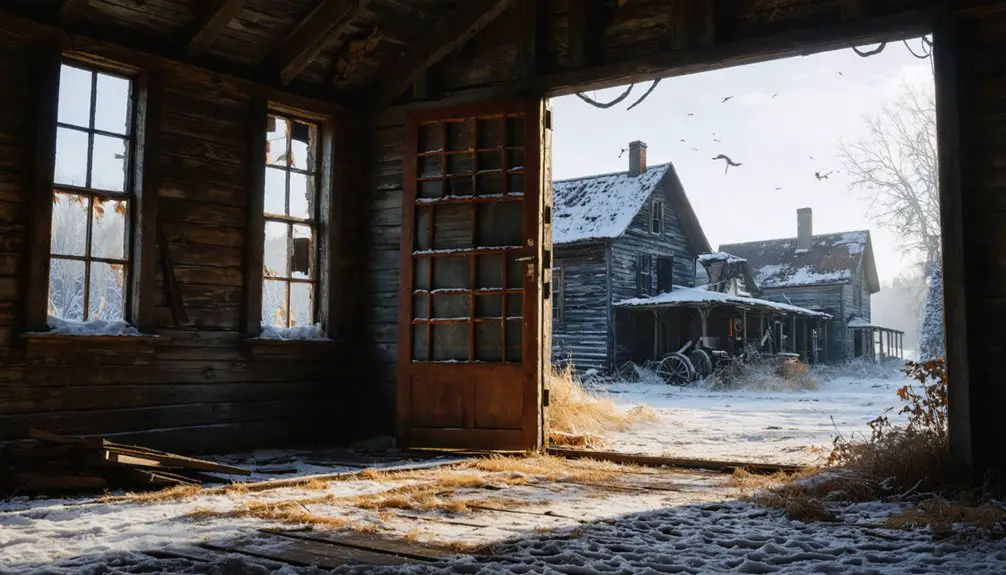
While Madrid’s growth seemed unstoppable in the late 1800s, signs of decline emerged as the town entered the 20th century. The economic shifts hit hard as traditional industries faltered, and demographic trends showed young residents leaving for urban opportunities. By 2000, the population had dwindled to just 173 people, down from 437 in 1880. The town’s early success was fueled by timber harvesting operations.
- Mills and mines that once provided steady employment shut down one by one.
- Railway connections that had brought prosperity fell into disuse.
- Schools, churches, and local businesses closed their doors.
- Housing and infrastructure deteriorated without proper maintenance.
The final blow came in April 2000 when Madrid lost its municipal status due to civic apathy. The former boomtown became part of East Central Franklin unorganized territory, marking the end of its independence.
Preserving Madrid’s Heritage Today
Despite its earlier decline, modern Madrid has experienced a remarkable cultural renaissance through dedicated preservation efforts.
You’ll find over 40 thriving businesses housed in carefully restored historic buildings, including former coal miners’ homes now transformed into art galleries, shops, and studios.
Heritage preservation efforts center around community involvement, with local artists and volunteers leading restoration projects throughout the town.
The iconic Mine Shaft Tavern, rebuilt in 1947, stands as a symbol of Madrid’s resilience, featuring its original historic bar.
The Coal Mining Museum safeguards artifacts and stories from the town’s mining era, while interpretive tours and signage help visitors connect with Madrid’s rich past.
Annual events like the Christmas light parade continue to celebrate the town’s unique heritage while supporting ongoing preservation work.
Legacy of a Lost New England Town
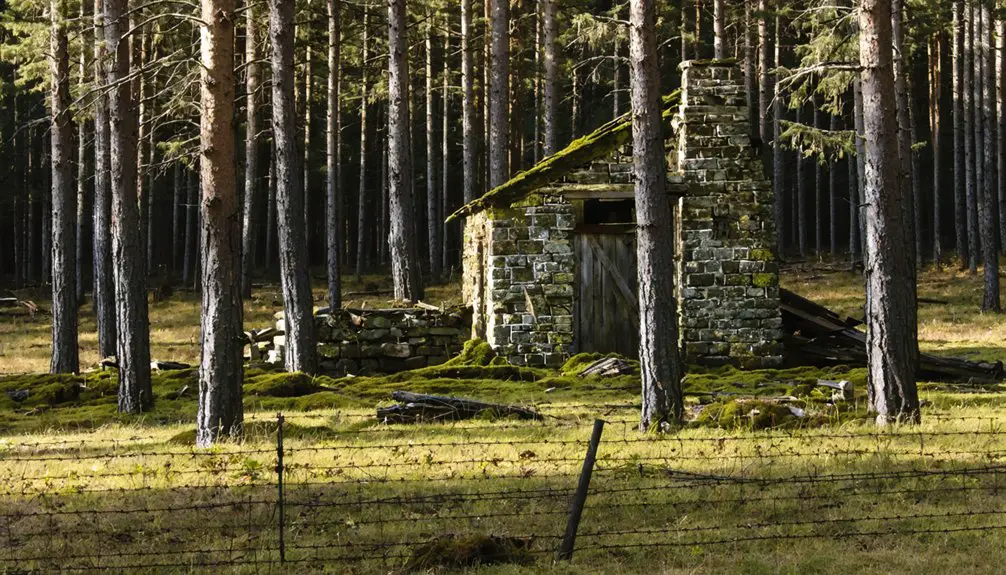
Beyond the preserved buildings and cultural celebrations lies a deeper story of Madrid, Maine’s remarkable journey from frontier settlement to ghost town.
The town’s cultural significance extends far beyond its physical remains, serving as a poignant reminder of New England’s industrial evolution and economic impact on small communities.
- You’ll find Madrid’s story reflected in its changeover from a thriving agricultural settlement to a bustling mining town that produced 180,000 tons of coal at its peak.
- The town’s prefabricated miners’ houses tell of a mobile workforce that shaped the region’s industrial landscape.
- Madrid’s disincorporation in 2000 represents the challenges faced by resource-dependent communities throughout New England.
- The ghost town’s enduring folklore and mining artifacts continue to draw visitors, preserving the memory of this lost community.
Frequently Asked Questions
Are There Any Reported Ghost Sightings in Madrid’s Abandoned Buildings?
Silent as a tomb, you won’t find any documented ghostly encounters or spectral legends in Madrid’s abandoned buildings. Historical records and local archives don’t mention any paranormal activity in this Maine ghost town.
What Happened to the Gold Mines After the Initial Discovery?
You’ll find the gold mine operations quickly faded after 1854, giving way to coal mining instead. Limited deposits couldn’t sustain profitable gold extraction, and the mining industry impact shifted toward other local resources.
Can Visitors Legally Explore and Photograph the Remaining Structures Today?
Among crumbling ruins and weathered wood, you’ll need private property owners’ permission to legally explore structures. You can photograph from public roads, but legal restrictions limit interior access and close-up photography.
Did Any Famous Historical Figures Ever Visit or Live in Madrid?
You won’t find any famous visitors or nationally known figures in Madrid’s history – its historical impact came from local settlers, farmers, and workers who shaped the town’s development and industries.
What Natural Disasters or Significant Events Contributed to Madrid’s Decline?
You won’t find any major natural calamities or mining accidents driving Madrid’s decline. Instead, economic factors like industrial shifts, population loss, and reduced services gradually eroded the town’s liveliness over time.
References
- https://www.hotels.com/go/usa/ghost-towns-maine
- https://en.wikipedia.org/wiki/Madrid
- https://newenglandwithlove.com/ghost-towns-in-maine/
- https://keyw.com/6-maine-ghost-towns/
- https://b985.fm/6-maine-ghost-towns-you-never-knew-existed/
- https://everything-everywhere.com/the-history-of-madrid/
- http://new-madrid.mo.us/131/Historical-Marker-Dedication
- https://en.wikipedia.org/wiki/Spanish_colonization_of_the_Americas
- http://www.new-madrid.mo.us/128/Growth-of-New-Madrid-Street-and-Place-Na
- https://www.themineshafttavern.com/madrid-history
